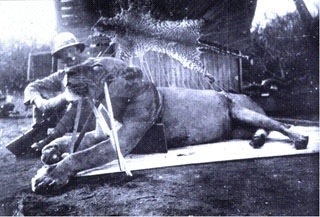It’s All in Your Heads – Mass Hysteria, Rampant Psychosomaticism and Contagious Hypochondria. Monday, how a town danced themselves to death.
Today: Honey, I Shrunk the Dong – The Todger Inversion Delusion
 In the “Seinfeld” episode where a naked, mortified George finds himself in a humiliated tizzy about shrinkage, imagine that, instead of engaging in whiny banter with Jerry, he runs screaming down to the kitchen, hand stretches his penis, mashes a stack of dinner plates on it to keep it extended and then starts to cry and hyperventilate. Cue funky bass riff.
In the “Seinfeld” episode where a naked, mortified George finds himself in a humiliated tizzy about shrinkage, imagine that, instead of engaging in whiny banter with Jerry, he runs screaming down to the kitchen, hand stretches his penis, mashes a stack of dinner plates on it to keep it extended and then starts to cry and hyperventilate. Cue funky bass riff.
Sufferers of Genital Retraction Syndrome believe that their genitals are rapidly disappearing into their bodies – a situation that they perceive as not only shameful, but also fatal. GRS, a very real fake malady, is a psychological syndrome akin to a panic attack, but one which feeds on sexual guilt, sexual ennui or sexual dissatisfaction. It’s most prevalent in cultures that hyper-moralize sexuality while also using sexual prowess as a barometer for measuring masculinity. As such, its perceived onset is generally viewed by the afflicted as a punishment for either sexual immorality (masturbation, hooker purchases, etc.) or their inability to please a sexual partner. The resultant panic and anxiety, of course, lead to further shrinkage and, as a result, often drive sufferers to employ a variety of household ephemera – shoelaces, chopsticks, fishhooks, kitchen tongs – in rigging up painful ad hoc penile extenders. (In rare cases, GRS affects women, who became convinced that their nipples or vulvae are retracting.)
The whole business of GRS is most common to Asia and Africa, and only became a popular topic of conversation among sniggering anthropologists after a 1967 epidemic in Singapore (where GRS is known as “Koro,” meaning, appropriately, “head of the turtle”) that found thousands of men desperately yanking and tugging themselves into a screaming panic. The mass freakout only ended after the government launched a massive educational campaign to assure dudes that their little soldiers weren’t in danger of going permanently AWOL. What the Singapore epidemic underscores is the tendency to mystify aspects of the human condition, even when they relate to things as concretely rational as biology – these cultures have, and understand, medicine, but in ascribing masculinity and sexuality to a morally policed intangible divinity, the sexual organs come to be

 Welcome to the Weird Things podcast featuring Andrew Mayne, Brian Brushwood and Justin Robert Young.
Welcome to the Weird Things podcast featuring Andrew Mayne, Brian Brushwood and Justin Robert Young. In the “Seinfeld” episode where a naked, mortified George finds himself in a humiliated tizzy about shrinkage, imagine that, instead of engaging in whiny banter with Jerry, he runs screaming down to the kitchen, hand stretches his penis, mashes a stack of dinner plates on it to keep it extended and then starts to cry and hyperventilate. Cue funky bass riff.
In the “Seinfeld” episode where a naked, mortified George finds himself in a humiliated tizzy about shrinkage, imagine that, instead of engaging in whiny banter with Jerry, he runs screaming down to the kitchen, hand stretches his penis, mashes a stack of dinner plates on it to keep it extended and then starts to cry and hyperventilate. Cue funky bass riff. 



